



Improving Pig Welfare Reduces Carcass and Financial Losses
The ability to reduce many of the financial losses associated with condemnations resulting from tail-biting is within the control of the producer, according to Dr Laura Boyle of Moorepark following two studies presented at the Pig Farmers' Conference organised by Teagasc in the Republic of Ireland in October 2012. Co-authors of the paper were from University College Dublin and Queens University in Belfast.Introduction
Recently, the Department of Agriculture Food and the Marine agreed to support a
project led by Teagasc to investigate the potential for including measures of pig
health and welfare in the meat inspection process at pig slaughter factories.
Currently, ante-mortem inspection of slaughter pigs and meat inspection (post-mortem)
in Irish abattoirs fulfils a public health role whereby the primary function
is to ensure food safety. The project proposal was underpinned by two studies
that were conducted by a collaborative team of researchers from Teagasc, UCD
and Queens University Belfast.
Preliminary findings from the first project, in which
data from over 36,000 slaughter pigs was collected from six factories in Ireland
and Northern Ireland (NI) were presented at the 2010 Teagasc Pig Conference.
These data were subsequently analysed further and interesting factory and
jurisdiction differences in the condemnation rate and reasons for condemnations
will be presented in this paper.
Subsequently a second study conducted in April 2012 was based in one factory in Ireland focused on the relationship
between different types of welfare lesion and carcass condemnations. In addition
to tail biting lesions, the prevalence and carcass condemnation/trimming
implications of loin bruising (associated with excessive mounting behaviour) and
hind-limb bursitis were also investigated. Estimates of the financial impact of
carcass condemnations were made from the data collected in both studies.
Methodology
Study 1
Over 35,000 pigs killed at five abattoirs (three in the Republic of Ireland [ROI] = Factories A, B and C and two in Northern Ireland – Factories D and E) during July and August 2010 were included in the study. They were in 250 different batches from 221 farms. Two trained observers recorded the gender, tail length and tail lesion score of each pig. Tails were scored according to severity on a five-point scale (Figure 1).

Batch-level results on reasons for and anatomical location of partial and entire carcass condemnation were obtained from abattoir records. Post-mortem meat inspection was carried out by trained Meat Inspectors in NI and Temporary Veterinary Inspectors (VI) in ROI.
Study 2
Data were collected in a single abattoir in the Republic of Ireland (ROI) by four people over seven days during April 2012. Measurements were taken from every third pig on the slaughter line. A full dataset was available for 3433 pigs in 79 batches from 49 farms. Tails were scored using the same scoring system as in Study 1. Loin-bruising was recorded using a score of 0 or 1 (Figure 2).
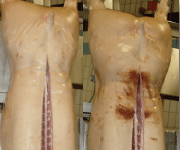
The reasons for, and anatomical locations of, carcass condemnation and carcass trimmings were recorded at the point of meat inspection and were based on the decision of the acting VI. Hind limb bursitis was recorded as present or absent. Partial condemnations and trimmings were weighed by a third person. It was not possible to weigh carcasses that were condemned entirely.
Results
Study 1
Docking and tail lesions
Over 99 per cent of the study pigs were docked and 58.1 per cent had some sort of tail lesion.
The majority of tail lesions were mild and severe lesions were detected in 1.03 per cent
of pigs. There was a higher prevalence of tail lesions in males (61.6 per cent) than
females (54.3 per cent), and this trend became more pronounced with increasing lesion
severity (Scores 3 and 4: 1.52 per cent of males affected versus 0.50 per cent of females
affected).
Differences between factories and jurisdictions
Tail lesions
There was huge variation between factories in the proportions of pigs with
different tail injury scores (Table 1). At the worst factory (Factory A), only 24 per cent of
pigs had normal tails with 1.78 per cent having severe injuries. This level of damage
was higher than the national average of 1.36 per cent. At factory C, 50 per cent of the pigs
inspected had normal tails but this factory had the second highest rate of
severely damaged tails (1.32 per cent). Factory E had the lowest rate of severely
damaged tails (0.34 per cent). As there is a lower risk of disease (and injury) in smaller
herds it is possible that part of the reason why factory E had the lowest level of
severe tail injuries could be related to the fact that it was supplied by the smallest
herds (indicated by the low mean batch size of 75). Indeed Factory A had the
worst results for tail injuries and it was supplied by the largest farms as indicated
by the largest mean batch size of 179 pigs.
Although fewer pigs were sampled in NI than in ROI a similar number of batches
and farms were sampled in both jurisdictions (Table 1). A slightly higher
proportion of pigs in NI had normal or only mildly damaged (i.e. score 1) tails
compared to ROI. However, jurisdiction differences were most pronounced for
severe tail-lesions (scores >2) with more than double the amount of pigs affected
in ROI (1.36 per cent) compared to NI (0.53 per cent).
Condemnations
The condemnation rate varied between 0.74 per cent and 2.28 per cent between factories.
Partial condemnations accounted for over 60 per cent of condemnations (except for
abattoir B, 42.6 per cent) (Table 1). Both the rate of entire and partial condemnations
differed significantly between factories. Forequarter condemnations varied
between 0 and 38.4 per cent while hindquarter condemnations varied between 34.1 and 93.1 per cent. Abscessation and arthritis were important causes of condemnation in all factories.
Some of the variation between factories could be accounted for by the variation in
the quality, consistency and accuracy of the meat inspection data obtained from
the abattoirs. The data ranged from standardised and computerised records, to
hand-written, and sometimes barely legible sheets of paper using variable
terminology. It is impossible to fully explain why condemnations in pig meat
factories vary so much while these inconsistencies persist. There are likely to be
a myriad of other issues at play and these include farm level factors,
transportation factors, pre-slaughter handling and management in the lairage and
pre-stunning. The fact that in one factory condemnations due to bruising were
notably high (13.2 per cent) compared to the others (c. 2 per cent) reflects poor pig welfare
possibly because of poor handling and/or overstocking during transportation or in
lairage. Factory E was the only factory in which there were no condemnations for
bruising suggesting that pigs might be handled more gently there. This could be
related to the low daily throughput of pigs (4000 pigs slaughtered per week) in
that factory.
The condemnation rate was higher in ROI (1.45 per cent) compared to NI (1.13 per cent) and
there were was a much higher condemnation rate of entire carcasses in ROI
compared to NI (37.8 vs. 11.1 per cent) (Table 1). Correspondingly there was a lower
proportion of partial carcass condemnations in ROI (61.2 per cent) compared to NI
(88.9 per cent). There was at least one carcass condemned in over 40 per cent of the batches
sampled in ROI while only 14.3 per cent of the batches sampled in NI had at least one
carcass condemned. Jurisdiction was also a significant factor in forequarter
condemnations with more than double the number of forequarters condemned in
NI (36.8 per cent) compared to ROI (16.5 per cent). More hindquarters were condemned in
ROI than in NI. The frequency of abscessed lesions in ROI (64.7 per cent) was 20 per cent
higher than in NI (42.0 per cent) whilst NI recorded over nine times the frequency of
arthritis of ROI (44.4 per cent vs. 4.68 per cent).
Differences between jurisdictions could result from differences in health and
welfare standards on farms and during transport between NI and ROI. The lower
proportion of pigs affected by severe tail lesions and the related finding of fewer
condemnations for abcessation in NI go some way towards supporting this. There
is a strong relationship between batch size and farm size. Hence the smaller
average size of batches supplied to factories in NI is linked to the smaller size of herds in the north. As the risk of disease and injury is lower in smaller herds this
could partially explain the substantially lower rate of condemnation of entire
carcasses in NI compared to ROI. Nevertheless, both judiciaries are governed by
the same EU legislation governing pig welfare on farm and during transport.
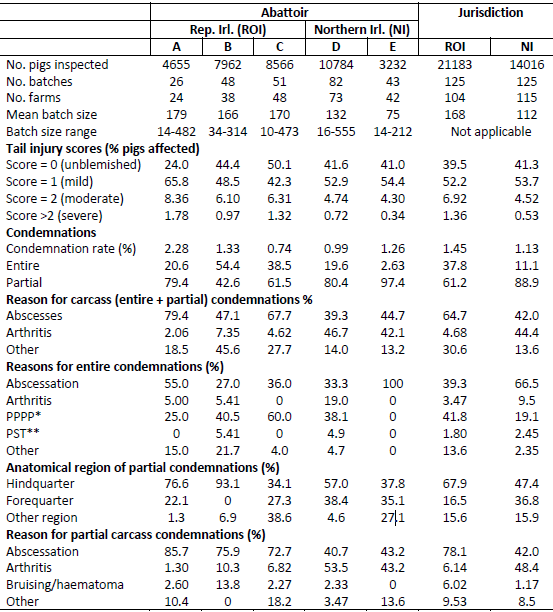
*PPPP=pleurisy/pneumonia/peritonitis/pericarditis;**PST=pyaemia/septicaemia/toxaemia
Finally, the fact that abattoirs in NI are also supplied by farms from ROI suggests
that abattoir level (meat inspection criteria and data capture) rather than farm
level (management, herd health status) or transportation differences were also
likely to contribute to the variation between jurisdictions. For example the specific
codes for conditions causing condemnation used in the automated APHIS-online
systems in NI means that there is likely to be much less variation than in ROI
where terminology varies from factory to factory.
Financial impact of carcass condemnations
Economic analysis was restricted to the NI abattoirs from which data on carcass
condemnation weights were available as such information is not routinely
collected in ROI. Data for economic analysis were also available from a 3rd
factory in NI (Factory F). Based on the EU-27 market price (€/kg) for July 2010
(EU Pig Management Committee, 2010) losses of €5,492.63 were incurred from
the 171 condemnations that occurred in these three NI factories. This equated to
an average loss of €0.37 per pig slaughtered in the study population of 14,794
pigs which was over five per cent of the net margin for pig production at the time of the
study (BPEX, 2012).
Study 2
Welfare (tail injuries, loin bruising and bursitis) lesions
Study 2 was conducted at one factory in ROI in 2012 and a much higher
percentage of pigs were affected by tail lesions (i.e. tail score >0 = 72.5 per cent, Table
2) compared to the mean figure of 58.1 per cent recorded over 5 factories in Study 1.
Furthermore, 2.5 per cent of pigs had severe tail lesions (i.e. TS >2).
Similar to Study
1, males were more frequently affected than females, a trend which also became
more exaggerated with increasing tail lesion severity. Severe loin-bruising
affected 16 per cent of pigs and severe hind limb bursitis was detected in 44 per cent of the
study population. In contrast to tail damage, there was no difference between the
genders.

Condemnations
The condemnation rate was 2.5 per cent with the majority of carcasses being partially
condemned (Table 3). The hindquarters were the most commonly affected
anatomical region. Over 85 per cent of carcass condemnations were due to infectious
conditions. Abscessation lesions alone accounted for almost 70 per cent of carcass
condemnations. Carcass trimming occurred more frequently than carcass
condemnation with 3.2 per cent of carcasses affected. Cumulatively 5.5 per cent of carcasses
in the study population were either trimmed or condemned.
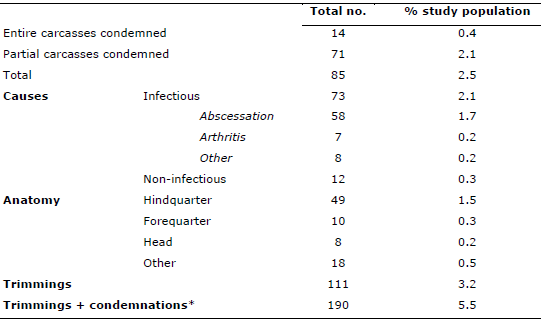
*5 pigs had both trimmings and condemnations
Tail lesion severity affected all carcass condemnation outcomes (Table 4). Of total carcass condemnations, 2.5 per cent of carcasses with tail score ?1 and 14.9 per cent of carcasses with a tail score ?3 were condemned respectively (Table 4). There was also a 10-fold increase in the proportion of trimmed carcasses between tail scores >1 (3.4 per cent) and tail scores >3 (32.2 per cent). The other welfare lesions (i.e. loin bruising and hind limb bursitis) did not show a relationship with any of the condemnation outcomes shown in Table 4. Multivariate analysis revealed that while tail lesions increased the risk of condemnation being female was protective for carcass condemnation.
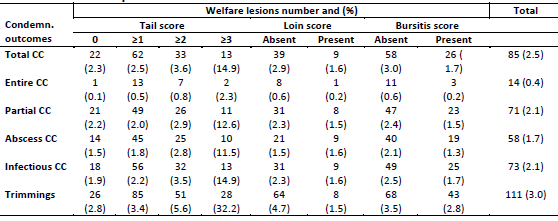
Financial impact of carcass condemnations
Partial condemnations and trimmings from the study pigs at the point of meat inspection were weighed by one of the investigators. It was not possible to weigh carcasses that were entirely condemned. The direct financial losses were calculated by multiplying recorded weights by the average Irish pig meat price during the study (€1.49/kg). For entirely condemned carcasses, the average weight recorded in the NI abattoirs during the 2010 study was used. Almost €2,700 of pig meat was lost from the 85 carcasses that were partially or entirely condemned from the study population. Because of the high condemnation rate at this factory (2.48 per cent) this equates to €0.79 per pig, increasing to €0.82 per pig if costs associated with the approximately 1,900kg of trimmings made at the point of meat inspection are included (Table 5).
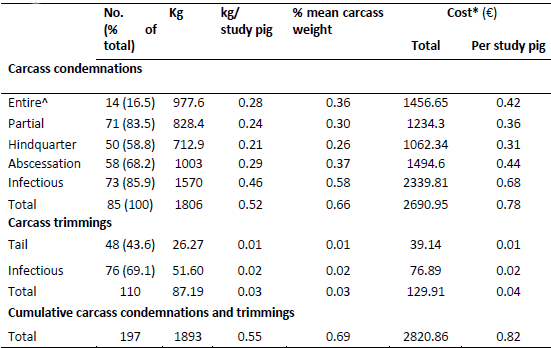
* based on average Irish value of pig meat over the study period (€1.49/kg)
^ based on average weight of entirely condemned carcasses recorded in NI in 2010
Implications of These Findings
Welfare lesions (tail injuries, loin bruising and bursitis)
- Routine tail docking is prohibited yet 99 per cent of Irish slaughter pigs were docked. The high prevalence of injured tails indicates that docking does not prevent tail biting.
- The high prevalence of tails with lesions observed in both the 2010 and 2012 study confirms tail-biting as a major and potentially increasing problem in Irish pig production.
- As tails were always scored by the same person and the impact of transportation on tail injury scores is negligible, the marked variation between factories in the prevalence of severely bitten pigs can only be attributed to variation in the housing and management of pigs on the farms supplying the factories and not to the factories themselves.
- The prevalence of tail injuries in the 2012 study is twice the figure reported for slaughter pigs in Finland and 10 times greater than equivalent figures for Sweden.
- Males are more frequently bitten than females. Although the frequency of biting is similar between the genders females bite more intensely than males. There is a need to investigate whether separation of the genders would reduce tail biting.
- The 2012 study confirmed anecdotal reports from processors that loin bruising is a problem in Irish slaughter pigs. This lesion is caused by mounting behaviour by entire males. On-farm factors such as over crowding exacerbate it. The trend towards lighter sale weights could help address this welfare problem.
- Carcasses with severe loin-bruising also incur costs associated with additional trimming to remove damaged tissue which increases labour and disposal costs. Affected cuts are downgraded, diminishing the retail value by over 50 per cent.
- High prevalence of severe hind-limb bursitis recorded in this study indicates that flooring used for pigs is suboptimal. The lower prevalence observed in finishing pigs in the UK, where straw-based systems are more common supports this theory.
Condemnations
- The proportion of carcass condemnations in the study population reflect what is reported in the literature for other countries.
- The majority were due to infectious conditions, the risk of which can be substantially reduced by improvements to the pigs environment.
- Abscessation was the greatest single reason for carcass condemnations corroborating the findings of other European studies. The relationship between abscessation and tail-biting was confirmed. Up to 61.7 per cent of abscesses result directly from tail-biting.
- There was an increased proportion of (infectious) disease lesions in victims of severe tail-biting, compared with pigs showing mild/no detectable tail lesions.
- Of all the factors tested, tail lesions had the greatest effect on carcass condemnations. This is not surprising as lesions arising from tail-biting provide not only a route of entry for infection but three separate routes for its dissemination around the body (venous, lymphatic and cerebro-spinal drainage).
- Female pigs are less likely to be condemned because they are less likely to be bitten.
- The lower condemnation rate and lower loss of entire carcasses in NI is likely to be related to the lower proportion of pigs affected by severe tail lesions in that jurisdiction.
- The potential impact of increasing herd size on pig health and behavioural vices warrants investigation.
- Variation in the quality, consistency and accuracy of meat inspection data precludes a clear understanding of reasons for differences between abattoirs and jurisdictions.
Financial
- There are significant direct financial implications of pathological conditions found at slaughter which can be as high as €0.78 per pig when the condemnation rate is over two per cent.
- This is greater than the profit margin for Irish pig producers. In the context of increased production costs - over 20 cents per kilo in a number of EU countries since 2010 (BPEX, 2012) – such losses represent a serious threat to the viability of pig farms.
- In reality the financial losses are likely to be much higher as indirect costs of carcass lesions were not accounted for in either study. These include costs incurred at farm level including wasted feed, medicines and labour at the processing stage because of the detection, removal and disposal of rejected parts and at retail in the form of lost market opportunities.
- Furthermore, costs associated with condemned viscera and fat trimming beyond the point of meat inspection were not included in the economic evaluation. These would push the cost of poor welfare, disease and injury leading to condemnations much higher.
Conclusions
There is no doubt that the ability to reduce many of the financial losses
associated with condemnations is within the control of the producer.
Abscessation and other infectious conditions are the main causes and control of
these can be achieved by addressing welfare issues on farm such as: re-mixing,
over-crowding, poor hygiene, damaged/inappropriate flooring, absence of
manipulable substrates and poor husbandry (i.e. injecting, tail and teeth clipping)
techniques.
If these issues can be resolved, the pigs welfare (and consequently
health status) should concurrently improve and there should be a reduction in
behavioural vices such as tail-biting which as this paper shows have an
overwhelming impact on carcass condemnations.
Further ReadingYou can view other papers presented at the conference by clicking here. |
January 2013








